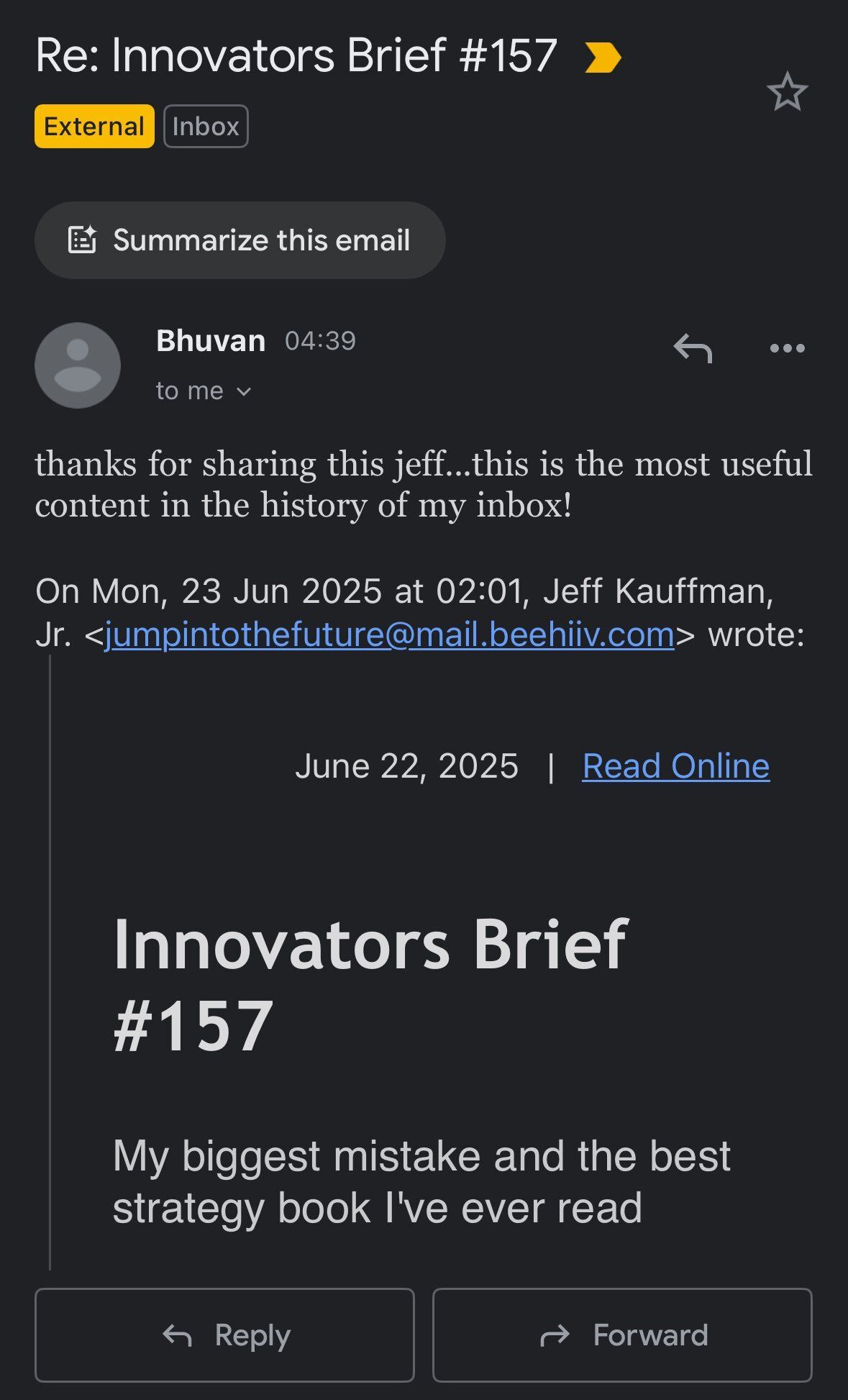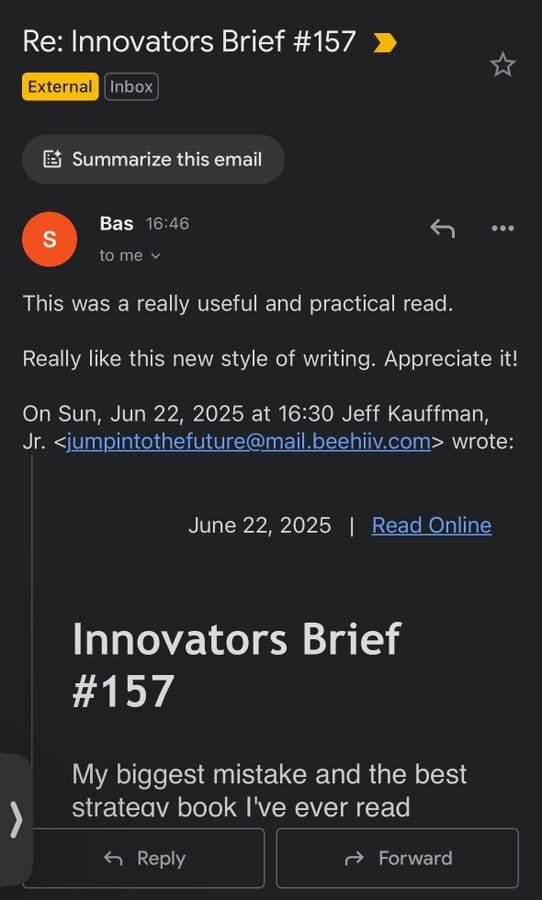Hey Jumpers,
The last brief was perhaps the most well-received email I’ve ever sent.
It’s responses like these that make writing these briefs well worth the effort!


For Today, Consider This Part 2 of Brief #157
I wanted to drill into both the timeless nature, and universal application, of Helmer’s 7 Powers across all industries, technologies, and inventions.
Here’s what we’ve got:
My favorite quote in the 7 Powers book
How even Bitcoin adheres to the laws of the 7 Powers
The company stages in which certain Powers are likely to emerge
My meme creator arc on LinkedIn
Prompt updates for the AI Strategy Assistant
Let’s jump in!
I Like Frameworks That Hold Up Over Time
Between AI and blockchain, the foundation of our digital world is changing extremely fast.
When Helmer wrote 7 Powers in 2016, Bitcoin was worth $358 and ChatGPT was 5 years away from its breakout moment.
In the book there’s not a single mention of AI or blockchain.
Yet, these are two of the most transformative technologies in history, and the 7 Powers framework holds up astonishingly well.
If I had read 7 Powers in 2016, I’m not sure I would have been as impressed.
For one, I was early enough in my career that I hadn’t learned some of the hard lessons you get to experience when you’re swinging for the fences.
Put another way, I didn’t have the business scars to know what matters most.
Second, mobile and social were not the new kids on the block.
Don’t quote me but I believe 2017 was the year that mobile Internet surpassed desktop, and no brand could pretend social media didn’t matter.
By 2016, the biggest tech trends were already well-established and most companies were past the, “what the fuck to I do with this phase.”
At the time, it would have been easy to read Helmer’s book and conclude that he’d done a great job at crafting a strategic framework that fit the current landscape of trends and technology.
But it’s only now, looking back, that I can truly appreciate how beautifully the 7 Powers framework has stood the test of time.
My Favorite Quote From 7 Powers
Before we dig into Bitcoin, here’s the quote I promised to share.
“Because disruptive technologies tell us nothing about Power they do not inform us about value … Invention is the first cause of Power. It does not necessarily lead to Power, but it can sometimes create the circumstances in which Power may be established.”
A bit of context here: Helmer’s definition of “invention” is broad. It’s not just limited to technology.
To him, invention can mean a creative idea, a supply chain innovation, or yes, new tech.
Invention is anything that didn’t previously exist and also leads to Power.
Applying the 7 Powers to Bitcoin
Let’s now apply them to Bitcoin to stress test the application of this framework.
When Bitcoin launched back in 2009, neither blockchain nor cryptography were brand-new.
Both actually had a long history up to that point.
It wasn’t until Satoshi invented the “recipe” for Bitcoin that real Power was created through the use of those two technologies.
If fact, neither blockchain nor cryptography had enabled any form of Power up to that point.
It is important to fully appreciate that Satoshi’s inventions were far more strategic in nature than they were technical.
Helmer states that the two Powers most companies (or in this case, a cryptocurrency) are likely to establish first are Cornered Resource or Counter Positioning.
Whether you’re a startup or a 100-year-old company, if you exist but don’t hold a Power yet, those are the two you should be aiming for.
Only after acquiring one of those two can you go after the others.
Your dominant Power may evolve over time, but when it comes to launching or turning around a company, Cornered Resource and Counter Positioning are the most critical starting points.
Bitcoin’s Initial Power
In Bitcoin’s early years, both of these Powers were in play.
For Counter Positioning, Bitcoin leaned into the "alternative money" narrative. Later, it evolved into the "store-of-value" or "digital gold" narrative.
The fact that the Counter-Positioning narrative has evolved over time suggests it wasn’t the most critical factor to Bitcoin’s Power.
Also, others had tried to launch digital currencies before. They failed. So while Counter-Positioning attracted early adopters, it wasn’t the thing that secured Bitcoin’s long-term edge.
The edge came from Cornered Resource.
Bitcoin’s founding Cornered Resource was the hard-coded cap of 21 million coins combined with 50-BTC block rewards every ten minutes.
In 2009–10 a handful of early miners could acquire large stakes at near-zero cost, locking up a scarce digital asset whose supply could never be replicated on any competing chain without abandoning Bitcoin’s proven ledger.
That irreversible first-mover allocation became the economic bedrock, and incentive system, that drew security, liquidity, and ultimately durable strategic advantage around the network.
Bitcoin’s Power and Moats Today
Fast forward to today, and Bitcoin’s most powerful moat is Network Economies.
Every new user, wallet, node, and institutional product strengthens the value and resilience of the entire system.
Close behind is Brand: Bitcoin is not just a currency, it’s a category-defining symbol of digital scarcity and financial sovereignty.
While Brand amplifies trust and adoption, it’s the compounding force of the network that makes Bitcoin almost impossible to displace.
Final Thought
When the Innovators Brief launched, we mostly covered the web3 space. I wish I had known about the 7 Powers in 2021.
I would have relentless evaluated everything through the lens of Cornered Resource and Counter Positioning since those are the first two Powers startups can most likely acquire.
One of the most promising aspects of web3 though is Network Economies.
I think the biggest mistake people have made in web3 is attempting to launch straight into Network Economies before fully establishing a Cornered Resource or Counter Position.
Either way, it is really impressive that the 7 Powers framework applies so perfectly across everything from crypto to DTC brands.
And that’s a wrap for today’s brief!
P.S. There’s a lot to unpack at the intersection of “community-as-a-moat” and Network Economies. Hoping to dive down this rabbit hole soon!
My Meme Creator Arc on LinkedIn
Up until this week, I’ve mostly kept my meme posting to X/Twitter.
I honestly don’t think posting memes on LinkedIn will go over that well, haha.
Everyone is so serious on LinkedIn.
That said, I can’t help but feel the need to put out some not-so-serious vibes.
Let the games begin.
🧠 Build Your Own AI Strategy Assistant
Want to start thinking more strategically in the age of AI? As execution becomes faster and cheaper, your edge won’t come from doing more. It’ll come from knowing what not to do. In a world of infinite output, strategy is the ultimate skill. Here’s a simple, high-leverage way to create your own AI Strategy Assistant, powered by your favorite AI and grounded in Hamilton Helmer’s 7 Powers.
Last week, I shared version one of a prompting sequence that helps you create your own AI Strategy Assistant.
I’ve made some updates to the prompts, so give this a try and let me know what you think!
Just copy and paste these prompts to get started:
Prompt 1 — Give it context:
“Please summarize the 7 Powers framework by Hamilton Helmer, including a brief explanation of each power, benefits and barriers, and when it tends to appear in a company’s lifecycle.”
Prompt 2 — Define strategy for your role:
“Now define strategy from the perspective of an entrepreneur, marketer, and product builder. How should someone use the 7 Powers to make smarter strategic decisions?”
Prompt 3 — Set its role:
“Act as an expert strategist who uses Helmer’s 7 Powers as your core framework. All other strategy tools (like Porter’s 5 Forces, Blue Ocean, or JTBD) should only be used to clarify or strengthen one of the Powers. When I ask you business, marketing, or product questions, evaluate ideas through this lens.”
That’s it. You’ve now created your own AI-powered strategy assistant that specializes in helping entrepreneurs, marketers, and product builders.
Use it to analyze ideas, sharpen your thinking, or challenge assumptions. The more you ask, the more useful it becomes.
Bonus: Make It Your Own
Think of these three prompts as your base model, not a finished product.
You can (and should) layer in your favorite frameworks to customize the assistant for your world.
Already using Jobs To Be Done? Add your JTBD canvas and ask the assistant to connect it to the Power you're pursuing.
Trying to diagnose a go-to-market issue? Plug in your last client strategy brief and see what patterns it surfaces.
Strategy frameworks are only useful if they move you closer to Power.


